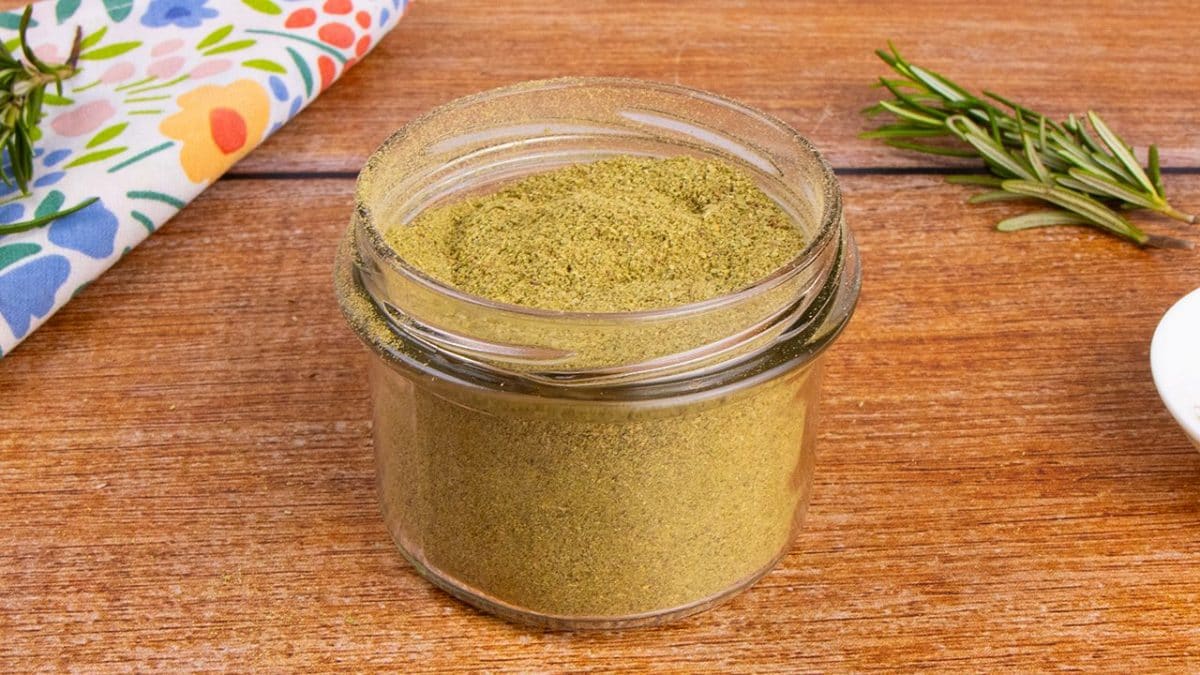
Homemade rosemary powder is a fragrant, versatile spice made by drying and grinding rosemary sprigs. It’s perfect for anyone who loves enhancing their dishes with aromatic herbs. Whether you're seasoning roasted potatoes, grilled meats, or Mediterranean sauces, this easy DIY blend packs a punch of flavor and freshness.
What Is Rosemary Powder?
Rosemary powder is a fine herb dust made by drying and grinding rosemary leaves. While fresh rosemary is wonderful, powdered rosemary is a shelf-stable version that’s easy to use and store. It has roots in Mediterranean cuisine, where herbs are used abundantly in slow-cooked meats, breads, and oils. This DIY method preserves the herb’s signature piney, lemony notes in concentrated form—making it a must-have in your pantry.
Why Everyone Will Love This Recipe
- Bold aroma, minimal effort – Just a few sprigs and a blender!
- It's natural, preservative-free, and made from a single ingredient.
- Ideal for home cooks, gardeners, or anyone trying to reduce kitchen waste.
- Works wonderfully in soups, stews, marinades, and spice rubs.
Pro Tips for the Best Rosemary Powder
- Use mature sprigs: Older rosemary has stronger oils and a deeper flavor.
- Dry completely: Any moisture left can lead to mold. Microwave drying is fast, but make sure the leaves are brittle before blending.
- Grind in bursts: Pulse the blender in short intervals for a finer texture without overheating.
- Sift if needed: For ultra-fine powder, use a mesh sieve after blending.
Frequently Asked Questions
Can I dry rosemary without a microwave?
Yes! Air-dry by tying sprigs and hanging them upside down for about a week, or bake them at a low temperature (around 150°F) until crisp.
What’s the shelf life of rosemary powder?
When stored in an airtight jar in a cool, dark place, it can last up to 6 months without losing potency.
Can I use a food processor instead of a blender?
Yes, though a blender generally gives a finer powder. A spice grinder is the best option if available.
How can I use rosemary powder in cooking?
It’s great in roasted vegetables, meat rubs, infused oils, and baking. Try it in focaccia or homemade crackers.
Is rosemary powder the same as ground rosemary sold in stores?
Homemade rosemary powder is often fresher and more flavorful. Store-bought versions may include additives or have been on the shelf longer.
How to Store
Transfer the rosemary powder into an airtight glass jar or spice container. Keep it away from heat, sunlight, and moisture—your spice rack or a pantry shelf works perfectly. Properly stored, it stays fresh and aromatic for 4 to 6 months.
How to Freeze
While not common, rosemary powder can be frozen to extend shelf life. Place it in a sealed freezer-safe bag with the air pressed out. It will keep for up to 1 year. Let it come to room temperature before using to avoid clumping from condensation.
Ingredients
How to Make Rosemary Powder
;Resize,width=712;)
Start by grabbing about eight sprigs of fresh rosemary. Give them a good rinse in a bowl of cold water to remove any dirt or garden residue—especially if they’re homegrown. Once clean, pat them completely dry using a kitchen towel or paper towel. This part is key—any leftover moisture can interfere with the drying process later. Now, take one rosemary sprig at a time and start stripping off the leaves. You’ll want to hold the top of the stem and gently pinch the base of the leaves with your fingers, sliding downward against the natural growth. The needles should come off easily. Discard the woody stems; we’re only using the leaves for the powder.
Start by grabbing about eight sprigs of fresh rosemary. Give them a good rinse in a bowl of cold water to remove any dirt or garden residue—especially if they’re homegrown. Once clean, pat them completely dry using a kitchen towel or paper towel. This part is key—any leftover moisture can interfere with the drying process later. Now, take one rosemary sprig at a time and start stripping off the leaves. You’ll want to hold the top of the stem and gently pinch the base of the leaves with your fingers, sliding downward against the natural growth. The needles should come off easily. Discard the woody stems; we’re only using the leaves for the powder.
Next, place the rosemary needles between two sheets of baking paper. This helps prevent scorching while allowing them to dry evenly. Pop them in the microwave for about two minutes, checking halfway through to ensure they’re drying—not burning.
;Resize,width=712;)
Next, place the rosemary needles between two sheets of baking paper. This helps prevent scorching while allowing them to dry evenly. Pop them in the microwave for about two minutes, checking halfway through to ensure they’re drying—not burning.
You’ll know they’re ready when they feel crisp and snap easily between your fingers. Once fully dried, transfer the leaves into a spice grinder, food processor, or high-speed blender. Pulse in short bursts to break down the needles into a fine, fragrant powder. If you prefer a super smooth texture, you can sift the powder through a fine mesh strainer to remove any remaining coarse bits.
;Resize,width=712;)
You’ll know they’re ready when they feel crisp and snap easily between your fingers. Once fully dried, transfer the leaves into a spice grinder, food processor, or high-speed blender. Pulse in short bursts to break down the needles into a fine, fragrant powder. If you prefer a super smooth texture, you can sift the powder through a fine mesh strainer to remove any remaining coarse bits.
Finally, pour your rosemary powder into a clean, airtight jar. Label it if you like—and that’s it! You’ve made your own rosemary powder in just a few minutes. Store it in a cool, dark place and use it anytime you want to add an herbal punch to your cooking.

;Resize,width=767;)
